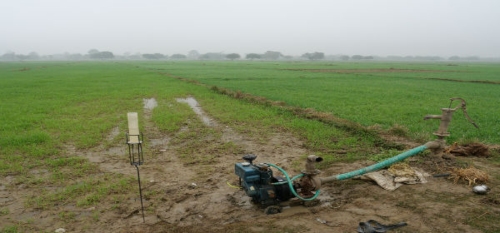
Water insecurity and poverty in India and Nepal
Dr Roshan Adhikari, Postdoctoral Research Associate at The University of Manchester’s Global Development Institute and Dr Tim Foster, Senior Lecturer in Water-Food Security in the Department of Mechanical, Aerospace and Civil Engineering, share their views about groundwater scarcity issues and how research at Manchester is helping to develop irrigation planning.
Addressing water scarcity in Southern Asia
Globally, 1.2 billion (about one in six people) live in areas with water shortages and scarcity, with almost half residing in Southern Asia. As 60% of rural households depend on agriculture for their livelihood, access to water for irrigation is critical in supporting food security for millions of resource-poor households.
Groundwater is a key source for irrigation, however access to cost-effective, reliable and adequate supplies isn’t consistent across the region. In the western Indo-Gangetic Plains (north-west India and Pakistan), farmers historically have benefited from widespread rural electrification and subsidised electricity. However, in the eastern Indo-Gangetic Plains (including Nepal, eastern India and Bangladesh) farmers remain largely dependent on unsubsidised diesel-powered pump irrigation systems.
Economic barriers to accessing groundwater
We’ve been working with the International Maize and Wheat Improvement Centre (CIMMYT) in South Asia to collect data from farmers in the eastern Indo-Gangetic Plains (EIGP) about the characteristics and costs of diesel-pump irrigation systems in the region.

Our work shows that there are huge disparities in costs of groundwater irrigation, ranging from $4/hectare to $170/hectare. We found that pumpset ownership appears to be a major driver of variable irrigation costs. The highest costs are borne by those farmers that depend on renting pumpsets for irrigation, who pay an average of $2.6/hour to access a pumpset.
Escaping cycles of poverty
These variations in irrigation costs have important implications for how farmers use irrigation and how resilient they are to climate shocks. We found that farmers facing higher irrigation costs reduce their use of irrigation inputs and have significantly lower agricultural productivity and profits.
This raises several important questions for scientists and policymakers: are we neglecting opportunities to make existing diesel pump systems more cost-effective for farmers? If so, could these deliver quick poverty reductions while supporting a transition to future low-carbon systems?
Our analysis highlights the need for irrigation development planning, and policy, to place greater emphasis on how to leverage complementary solutions to expand access to irrigation in the EIGP and other regions where diesel pumps are the de facto technology used by farmers.
Key policy priorities should include enhanced financial support through subsidies or credit systems to enable pumpset purchasing by poor water-insecure households and on-the-ground engagement to promote and support alternative, fuel-efficient, relatively cheaper, pumpset designs.
-
Dr Roshan Adhikari
Postdoctoral Research Associate, The University of Manchester’s Global Development Institute
View Dr Roshan Adhikari's research profile
-
Dr Tim Foster
Senior Lecturer in Water-Food Security in the Department of Mechanical, Aerospace and Civil Engineering, The University of Manchester
View Dr Tim Foster's research profile


